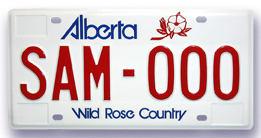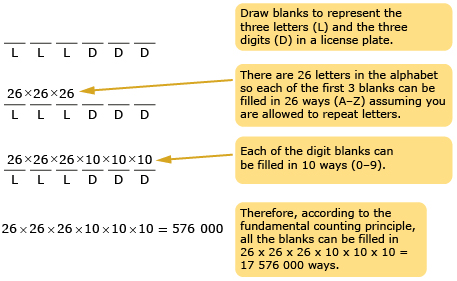Lesson 1
1. Lesson 1
1.6. Explore 5
Module 8: Permutations, Combinations, and the Binomial Theorem
As you realized in Try This 3, the fundamental counting principle can also be applied in situations where there are some choice restrictions. For example, if you want to determine the number of possible phone numbers, you need to know that you cannot use a zero as the first digit.
For many questions there is a more efficient way of calculating outcomes than drawing a tree diagram or creating an outcome table. In Try This 3 you investigated solving one problem by drawing blanks for the outcomes.

Courtesy of Alberta Motor Vehicles. Reproduced with permission
Another example to check out is how many license plates can be made with three letters (L) followed by three digits (D).

To view another example of using blanks to determine a solution, read "Example 1: Method 2" on page 518 of the textbook.
Self-Check 2

![]() Graham/25113263/flickr
Graham/25113263/flickr
Another way people are identified is by the license plate number on their vehicle. Historically, license plates in Alberta have consisted of three letters followed by three digits. Because the province is getting short of license plate numbers, Alberta is now changing the format to three letters followed by four digits. In 1997, Ontario switched from three digits followed by three letters to four letters followed by three digits.
- With a partner or in a group, determine how many more license plates are now available in Ontario with the fourth letter added. Answer
- You saw that the number of license plates in Alberta is 17 576 000 when the format is three letters followed by three digits. How many more license plates will be created in Alberta by adding the fourth digit? Answer
- Focus states that adding a new area code added a potential nine million more phone numbers in Alberta. How was this number calculated? Answer
![]()
- Do question 1 of “Check Your Understanding” on page 524 of the textbook. Answer